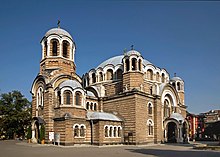Gorazd of Moravia
Saint Gorazd of Moravia ( Slovak : Svätý Gorazd , Czech : Svatý Gorazd ) was a Moravian priest , scholar and student of Methods , who named Gorazd in 885 shortly before his death as his successor as Archbishop of the Moravian Empire .
Life
There is little information about the life of the son of Great Moravian aristocrats. His parents, who are said to have lived in Močenok near Nitra ( Slovakia , German Neutra), intended him for a career in the church; he studied with Franconian clergymen. He was ordained a priest in 868 by Bishop Formosus in Rome . (A written note in the Uspenije Kirilla attests to his presence in Rome).
During the mission of Cyril of Saloniki and Method in Greater Moravia, he was one of the most devoted students of Method of Saloniki . He appointed him as his successor as chairman of the Great Moravian Academy and as archbishop before his death. He assumed that Gorazd would settle the linguistic disputes of the church during the service through his mediating gift and would receive the support of Prince Svatopluk I.
Due to the intrigues of Bishop Wiching from Nitra, however, he was not appointed archbishop. Rather, Gorazd was accused of heresy with other Method students at the Synod (?) 886 and imprisoned. There is no information about his fate in the following years. It is believed that he was either chased out of Great Moravia with other students, or that he stayed in his homeland as a local nobleman and retired to a castle.
When Mojmír II renewed the Great Moravian Church with the help of the Pope, three new bishops and an archbishop were appointed in 899 and 900. The latter could have been Gorazd. After the fall of Great Moravia, he probably fled with the bishops to Wislanien (Vistula region, today around Lesser Poland ). Other sources speak of an escape to Bohemia or Bulgaria .
František Dvorník and Tadeusz Milewski spoke out in favor of fleeing to Lesser Poland around Krakow . They referred to a Polish calendar from Wiślica , which mentions a Gorazd otherwise unknown in the Western Church. According to Nicolina Trunte , the name and cult […] are more related to the Slavic monastery founded in 1390 in Kleparz near Krakow .
The relics of Gorazd and those of St. Angelario are kept in the old Bulgarian district of Kutmichevitsa in the city of Belgrade (today Berat ) in southern Albania. Belagradon, the "white city" (Greek: Πουλχεριοπόλις = Poulcheriopólis "beautiful city") belonged to the (Western) Bulgarian Empire until its fall in 1018. In 1970 Dimitŭr Kalev drew attention to this centuries-long veneration, after which St. Gorazd of Moravia fled to the south-west Bulgarian countries together with other disciples of Cyril and Method such as Angelarius, Kliment and Naum.

Gorazd was later canonized . His feast day as one of the "Five of Ochrid ", also known as the "Five Number ", is July 27th . In Bulgaria even six other saints are venerated with Gorazd on July 27th, in addition to the "Five of Ochrid" also Method of Saloniki and his brother Kyrill as creators and spreaders of the Glagolitic and Cyrillic languages. There are even a number of churches in honor of these "Seven Saints" ( Bulgarian Седмочисленици ), for example in Sofia, Blagoevgrad and Veliko Tarnovo, as well as schools such as Sofia, Targovishte and Plovdiv .
Works
Since Gorazd with the life of St. Method and was his close companion, there is some evidence that he is the author of the Pannonian legend The Life of Method .
See also
literature
- Ľ. Bosák, P. Kýška, Lúč: Svätý Gorazd - Učený muž našej zeme. Bratislava 2004.
- J. Kuzmík: Gorazd Sloviensky: Teologické study. Odkaz Soluňských bratří. Sborník k 1100. výročí úmrtí sv. Metoděje, 88-93, Prague 1979.
- F. Janhuba: Žáci svatých Cyrila a Metoděje: Teologické study. Odkaz soluňských bratří. Sborník k 1 100. výročí úmrtí sv. Metoděje, 94-105, Prague 1987.
Individual evidence
- ^ Dvorník, Francis : Byzantine Mission among the Slavs: SS. Constantine-Cyril and Methodius . Rutgers University Press, New Brunswick, New Jersey 1970, ISBN 0-8135-0613-1 , pp. 198-202 (English, 484 pages).
- ↑ Nicolina Trunte : Словѣньскъи ѩзыкъ. A practical textbook of Church Slavonic in 30 lessons. At the same time an introduction to Slavic philology. Volume 2: Middle and New Church Slavonic. (= Peter Rehder (Ed.): Slavistic Contributions , Volume 494), 2nd, completely revised and expanded edition, Verlag Otto Sagner, Munich - Berlin - Washington, DC 2014, ISBN 978-3-86688-427-4 , P. 1, note 1.
- ↑ Dimitur Kalev: Sv. Gorazd, Slavjanski Prosvetitel. Sinodalno izd-vo, Sofia 1970.
- ↑ The Synaxarion - The Lives of the Saints of the Orthodox Church. In 2 volumes. Based on the 6-volume edition of the Holy Monastery of Simonos Petra. Second volume. March to August. Monastery of St. John the Forerunner, Chania (Crete) 2006, ISBN 960-88698-0-3 , p. 638 f.
- ↑ Nikolaj Velimirović : The prologue of Ohrid. Verlag Johannes A. Wolf, Apelern 2009, ISBN 978-3-937912-04-2 , p. 485.
- ↑ Vavřínek, Vladimír: Staroslověnské životy Konstantina a Metoděje . In: Rozpravy Československé Akademie Věd . Nakladatelství Československé Akademie Věd (NČSAV), Prague 1963, p. 3–9 (Czech, 123 p., With French resume).
| personal data | |
|---|---|
| SURNAME | Gorazd of Moravia |
| BRIEF DESCRIPTION | Great Moravian bishop and saint |
| DATE OF BIRTH | 9th century |
| DATE OF DEATH | 10th century |


